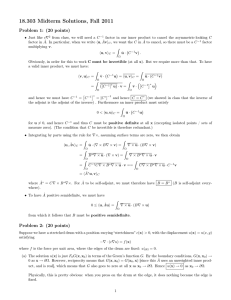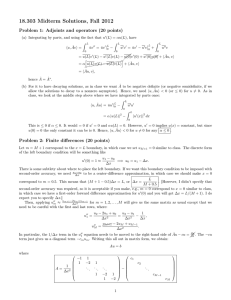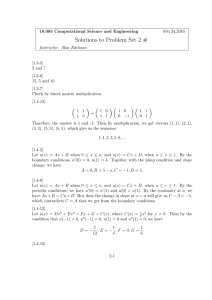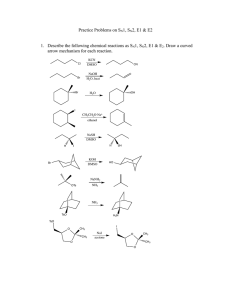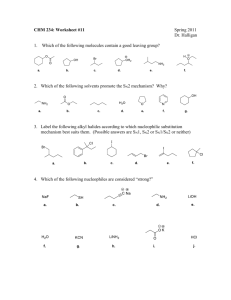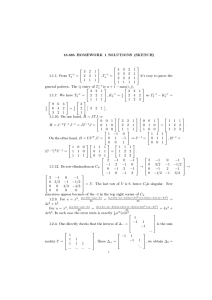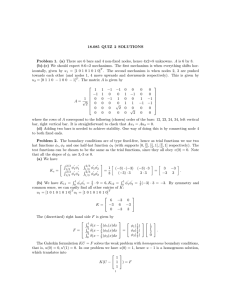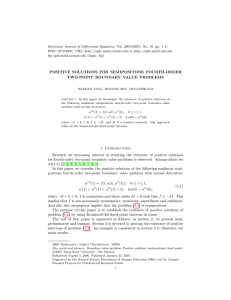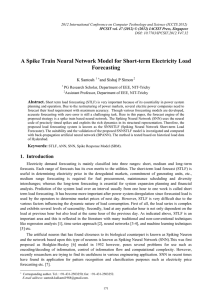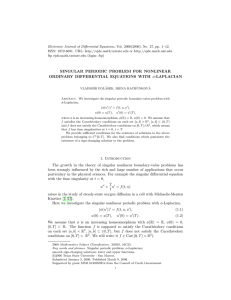18.303 Midterm Solutions, Fall 2013 Problem 1: (7+8+(5+10) = 30 points)
advertisement
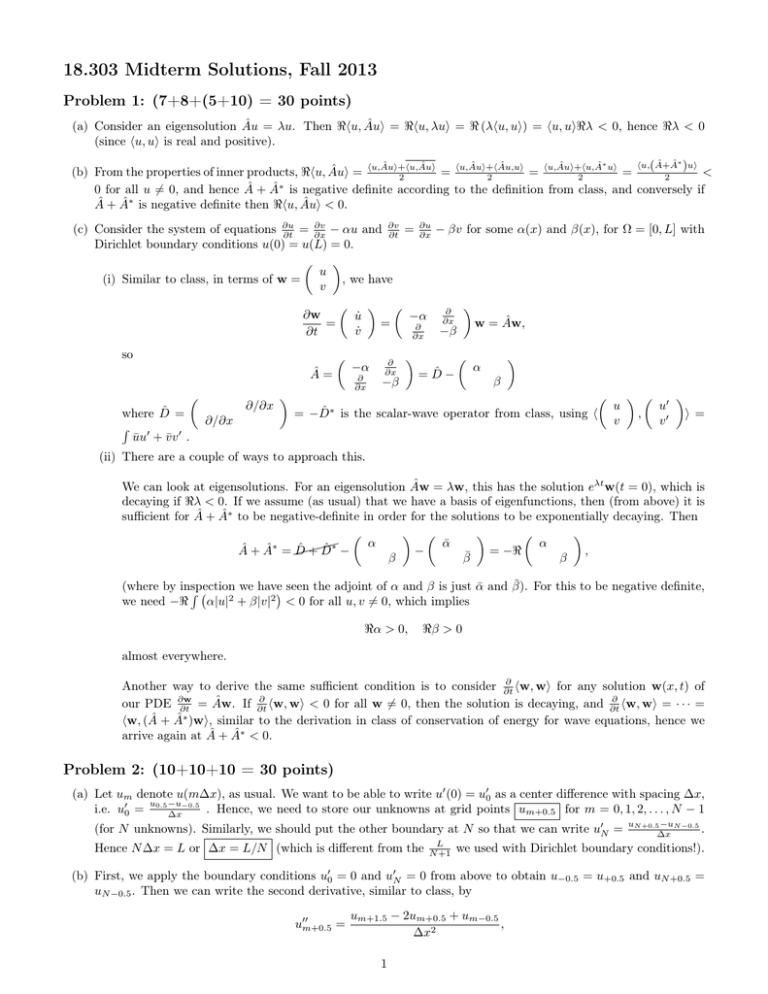
18.303 Midterm Solutions, Fall 2013 Problem 1: (7+8+(5+10) = 30 points) (a) Consider an eigensolution Âu = λu. Then <hu, Âui = <hu, λui = < (λhu, ui) = hu, ui<λ < 0, hence <λ < 0 (since hu, ui is real and positive). hu,(Â+Â∗ )ui Âui Âu,ui Â∗ ui (b) From the properties of inner products, <hu, Âui = hu,Âui+hu, = hu,Âui+h = hu,Âui+hu, = < 2 2 2 2 0 for all u 6= 0, and hence  + Â∗ is negative definite according to the definition from class, and conversely if  + Â∗ is negative definite then <hu, Âui < 0. ∂v ∂v (c) Consider the system of equations ∂u ∂t = ∂x − αu and ∂t = Dirichlet boundary conditions u(0) = u(L) = 0. u (i) Similar to class, in terms of w = , we have v ∂w = ∂t so  = where D̂ = R ūu0 + v̄v 0 . ∂/∂x ∂/∂x u̇ v̇ −α = −α ∂ ∂x ∂ ∂x ∂u ∂x ∂ ∂x − βv for some α(x) and β(x), for Ω = [0, L] with ∂ ∂x w = Âw, −β −β = D̂ − α β 0 u u = −D̂ is the scalar-wave operator from class, using h , i = v v0 ∗ (ii) There are a couple of ways to approach this. We can look at eigensolutions. For an eigensolution Âw = λw, this has the solution eλt w(t = 0), which is decaying if <λ < 0. If we assume (as usual) that we have a basis of eigenfunctions, then (from above) it is sufficient for  + Â∗ to be negative-definite in order for the solutions to be exponentially decaying. Then α ᾱ α  + Â∗ = D̂ + D̂∗ − − = −< , β β̄ β (where by inspection we have seen the adjoint of α and β is just ᾱ and β̄). For this to be negative definite, R we need −< α|u|2 + β|v|2 < 0 for all u, v 6= 0, which implies <α > 0, <β > 0 almost everywhere. ∂ hw, wi for any solution w(x, t) of Another way to derive the same sufficient condition is to consider ∂t ∂w ∂ ∂ our PDE ∂t = Âw. If ∂t hw, wi < 0 for all w 6= 0, then the solution is decaying, and ∂t hw, wi = · · · = ∗ hw, ( +  )wi, similar to the derivation in class of conservation of energy for wave equations, hence we arrive again at  + Â∗ < 0. Problem 2: (10+10+10 = 30 points) (a) Let um denote u(m∆x), as usual. We want to be able to write u0 (0) = u00 as a center difference with spacing ∆x, −0.5 i.e. u00 = u0.5 −u . Hence, we need to store our unknowns at grid points um+0.5 for m = 0, 1, 2, . . . , N − 1 ∆x (for N unknowns). Similarly, we should put the other boundary at N so that we can write u0N = Hence N ∆x = L or ∆x = L/N (which is different from the L N +1 uN +0.5 −uN −0.5 . ∆x we used with Dirichlet boundary conditions!). (b) First, we apply the boundary conditions u00 = 0 and u0N = 0 from above to obtain u−0.5 = u+0.5 and uN +0.5 = uN −0.5 . Then we can write the second derivative, similar to class, by u00m+0.5 = um+1.5 − 2um+0.5 + um−0.5 , ∆x2 1 where for the first row (m = 0) and the last row (m = N − 1) of the matrix we will have u000.5 = u1.5 − u0.5 u1.5 − 2u0.5 + u−0.5 = , ∆x2 ∆x2 uN +0.5 − 2uN −0.5 + uN −1.5 −uN −0.5 + uN −1.5 = 2 ∆x ∆x2 via the boundary conditions. Hence, A looks like u00N −0.5 = −1 1 1 A= ∆x2 1 −2 .. . 1 .. . 1 .. . −2 1 . 1 −1 (c) This A is obviously real-symmetric. To show that it is definite, the easiest thing to do, similar to class, is to factorize A as the product of two first-derivative operations. Let us construct the matrix D that computes u01 , u02 , . . . , u0N −1 from u0.5 , u1.5 , . . . , uN −0.5 . (Since u00 = 0 and u0N = 0, we need not compute them.) u01 u02 .. . u0N −1 −1 1 = Du = ∆x 1 −1 1 .. . .. . −1 u0.5 u1.5 .. . uN −1.5 1 uN −0.5 . Notice that D is (N − 1) × N . Similarly, to get u000.5 , u001.5 , . . . , u00N −0.5 from u01 , u02 , . . . , u0N −1 , we do: u000.5 u001.5 .. . u00 N −1.5 u00N −0.5 1 −1 1 = ∆x 1 .. . .. . −1 u01 u02 .. . 1 u0N −1 −1 = −DT u01 u02 .. . u0N −1 , where we have used the Neumann boundary conditions for the first and last rows. Hence A = −DT D, which is at least negative semidefinite. It is not negative definite, because it is easy to see that N (A) = N (D) contains the constant vector (1, 1, . . . , 1, 1)T . 2
